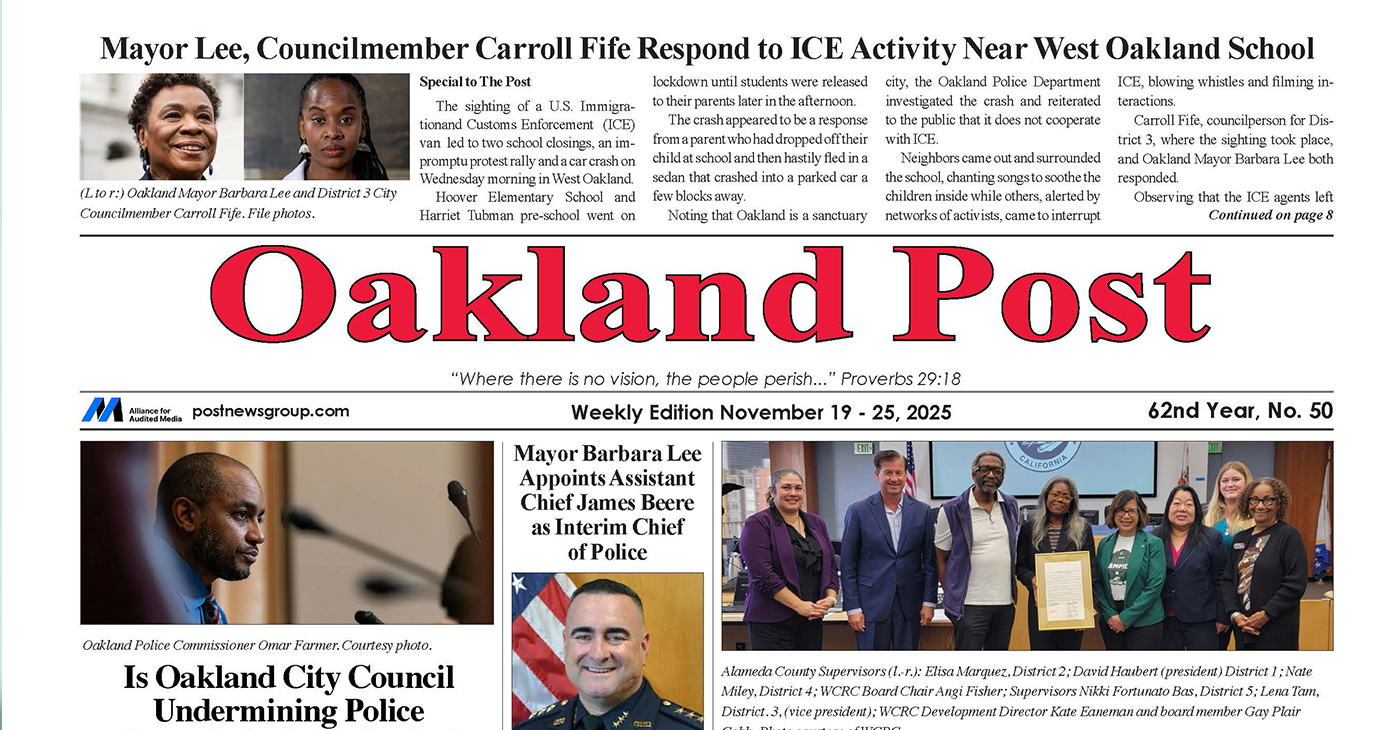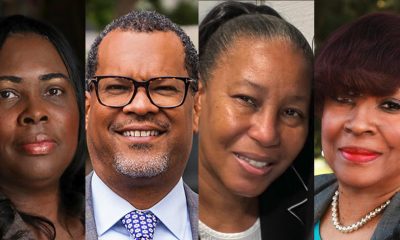Bay Area
Sondra Alexander Retires From OCCUR After 40 Years of Dedicated Service

Last week, Sondra Alexander quietly ended her 40 years of service at the Oakland Citizens Committee for Urban Renewal (OCCUR), the advocacy group that formed in the 1950s to close the gaps between rich and poor neighborhoods.
Alexander began her career at OCCUR in the late 1970s as assistant to Paul Cobb, now the Post News Group publisher, who led the program for her retirement party on Dec. 5.
Held at the David E. Glover Education and Technology Center in East Oakland, a project of OOCUR’s that she helped spearhead with its namesake, David Glover, who died in 2013, Alexander was praised and remembered by current and former OCCUR employees alike, bringing smiles and a few tears.
Glover’s sister, Angela Blackwell, founder of Policy Link, was present with her son, Fred Blackwell, who recalled coming to OCCUR offices as a child and simply feeling welcomed by Alexander. “That’s a big deal for a 9-year-old,” said Blackwell, who is now CEO of the San Francisco Foundation.
Olivia Cueva, the David Glover Center’s executive director, praised Alexander for her compassionate guidance and leadership, while OCCUR executive assistant Charla Montgomery regaled the attendees on her first few weeks at the job when she learned the value of multi-tasking, self reliance and pinching pennies for the greater good.
Also present were some of Alexanders’ sisters Ida, Nuna Mae, Donna, Crystal and Ennis along with many relatives and friends. Known for her strong faith-based and family ties, Alexander pledged to continue her support and involvement to keep the organization strong.
Over the years, Alexander served as director of administration and executive director. She will be replaced by Shomari Carter, a former staff assistant to Alameda County Supervisor Keith Carson.
If you ask Alexander to list her OCCUR related accomplishments, her answer would be “That’s difficult to say, because OCCUR’s successes are the result of a team effort.”
While it’s true that it takes an effective and cohesive team to fully achieve success, but there is always that one person that welcomes the challenge, assumes the responsibility, pulls the team together, manages the effort and does whatever it takes to ensure success. For the last 40 years, that person has been Alexander.
Alexander successfully implemented and administered over 50 programs and services designed to address the challenges faced by low-income individuals, small business owners, faith-based institutions and nonprofit organizations.
Throughout Sondra’s extensive career, she remained firmly rooted and driven in achieving the overall goal of raising the quality of life for all of Oakland/East Bay residents, but particularly for those in the greatest need.
Alexander was instrumental in developing and executing OCCUR’s place-based digital training project initiative — The Eastmont Technology Center, which was renamed for David Glover at her behest
As a result of her leadership efforts, DEGETC has gained increased notoriety throughout the San Francisco Bay Area as cutting age training program providing thousands of low-income adults, youth and seniors with the skills needed to participate in the technology-driven economy.
Alexander’s mastery of program development and administration, has helped to initiate and implement highly impactful programs such as, the Area Mapping and Neighborhood Profiles project for Oakland’s 7 districts, the Consumer Education/Cost Minimization program, Oakland Housing/Foreclosure Prevention program, Oakland Facade Improvement project and the Heartland Revitalization program.
She said she would marshal the efforts of her childhood friends Dr. Arnold Perkins and Paul Cobb to continue to support OCCUR’s fundraising programs..
Alameda County
Seth Curry Makes Impressive Debut with the Golden State Warriors
Seth looked comfortable in his new uniform, seamlessly fitting into the Warriors’ offensive and defensive system. He finished the night with an impressive 14 points, becoming one of the team’s top scorers for the game. Seth’s points came in a variety of ways – floaters, spot-up three-pointers, mid-range jumpers, and a handful of aggressive drives that kept the Oklahoma City Thunder defense on its heels.

By Y’Anad Burrell
Tuesday night was anything but ordinary for fans in San Francisco as Seth Curry made his highly anticipated debut as a new member of the Golden State Warriors. Seth didn’t disappoint, delivering a performance that not only showcased his scoring ability but also demonstrated his added value to the team.
At 35, the 12-year NBA veteran on Monday signed a contract to play with the Warriors for the rest of the season.
Seth looked comfortable in his new uniform, seamlessly fitting into the Warriors’ offensive and defensive system. He finished the night with an impressive 14 points, becoming one of the team’s top scorers for the game. Seth’s points came in a variety of ways – floaters, spot-up three-pointers, mid-range jumpers, and a handful of aggressive drives that kept the Oklahoma City Thunder defense on its heels.
One of the most memorable moments of the evening came before Seth even scored his first points. As he checked into the game, the Chase Center erupted into applause, with fans rising to their feet to give the newest Warrior a standing ovation.
The crowd’s reaction was a testament not only to Seth’s reputation as a sharpshooter but also to the excitement he brings to the Warriors. It was clear that fans quickly embraced Seth as one of their own, eager to see what he could bring to the team’s championship aspirations.
Warriors’ superstar Steph Curry – Seth’s brother – did not play due to an injury. One could only imagine what it would be like if the Curry brothers were on the court together. Magic in the making.
Seth’s debut proved to be a turning point for the Warriors. Not only did he contribute on the scoreboard, but he also brought a sense of confidence and composure to the floor.
While their loss last night, OKC 124 – GSW 112, Seth’s impact was a game-changer and there’s more yet to come. Beyond statistics, it was clear that Seth’s presence elevated the team’s performance, giving the Warriors a new force as they look to make a deep playoff run.
Activism
Oakland Post: Week of November 26 – December 2, 2025
The printed Weekly Edition of the Oakland Post: Week of November 26 – December 2, 2025

To enlarge your view of this issue, use the slider, magnifying glass icon or full page icon in the lower right corner of the browser window.
Activism
Oakland Post: Week of November 19 – 25, 2025
The printed Weekly Edition of the Oakland Post: Week of November 19 – 25, 2025

To enlarge your view of this issue, use the slider, magnifying glass icon or full page icon in the lower right corner of the browser window.
-

 Activism4 weeks ago
Activism4 weeks agoOakland Post: Week of November 12 – 18, 2025
-

 Activism3 weeks ago
Activism3 weeks agoIN MEMORIAM: William ‘Bill’ Patterson, 94
-

 Activism4 weeks ago
Activism4 weeks agoHow Charles R. Drew University Navigated More Than $20 Million in Fed Cuts – Still Prioritizing Students and Community Health
-

 Bay Area4 weeks ago
Bay Area4 weeks agoNo Justice in the Justice System
-

 #NNPA BlackPress3 weeks ago
#NNPA BlackPress3 weeks agoLewis Hamilton set to start LAST in Saturday Night’s Las Vegas Grand Prix
-

 #NNPA BlackPress3 weeks ago
#NNPA BlackPress3 weeks agoBeyoncé and Jay-Z make rare public appearance with Lewis Hamilton at Las Vegas Grand Prix
-

 Activism3 weeks ago
Activism3 weeks agoOakland Post: Week of November 19 – 25, 2025
-

 #NNPA BlackPress4 weeks ago
#NNPA BlackPress4 weeks agoThe Perfumed Hand of Hypocrisy: Trump Hosted Former Terror Suspect While America Condemns a Muslim Mayor





















































